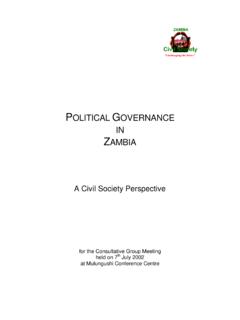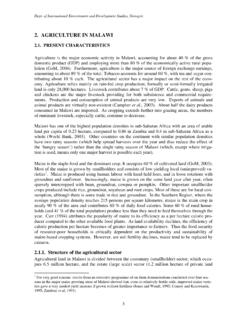Transcription of CHAPTER 19 PUBLIC SECTOR MANAGEMENT …
1 363 CHAPTER 19 PUBLIC SECTOR PUBLIC SECTOR is the principalactor in macro socio-economic policymaking infrastructure and an architect ofan enabling environment for nationaldevelopment. PUBLIC SECTOR managementcovers such aspects of MANAGEMENT asproductivitymanagement,andmanagement of human, financial andother resources. It involves an array ofactivitiesrangingfromplanning,formulat ionandimplementation ofpolicies, programmes and projects forthe delivery of goods and services to thenation through a number of governmentand quasi-government ,it isimperative that the structures, policiesand operations of the PUBLIC Sectorrespondadequatelytothesocio-econom ic needs of the nation, asarticulated in the Vision 2016, and toglobal challenges. This implies that thequality of the PUBLIC SECTOR managementis essential to the fulfillment of thetheme of the National Development Plan9: Towards Realization of the Vision2016:SustainableandDiversifiedDeve lopment through Competitivenessin the Global Market.
2 Directorate of PUBLIC ServiceManagement is mandated to provide theoverall policy framework in humanresource and productivity managementpractices. This CHAPTER will, therefore,restrict its discussion of the role of theDirectorateofPublicServiceManagement in the MANAGEMENT of thePublic SECTOR to the areas of humanresource and productivity and productivitymanagement policies and practices are tobe used in the PUBLIC SECTOR for effectivemanagement of the human capital andother resources required to deliver theNational Development Plan goals, andultimatelyachievethenationalaspiratio ns as enshrined in the Vision2016. The extent to which the goals ofthe National Development Plan 9, andconsequently those of the Vision 2016,are achieved is dependent on howeffectivelythehumanand otherresources will be applied to the deliveryof the planned programmes. It is,therefore, necessary that the envisagedPublic SECTOR MANAGEMENT policies andstrategies be succinctly spelt out in theNational Development Plan resource MANAGEMENT policiesand other MANAGEMENT practices in thePublic SECTOR , developed within themacro policy framework provided by theDirectorateofPublicServiceManagement, aredonethroughinstitutional arrangements with specificfocus and clientele.
3 This is intended tocater for the special needs of thecomponents of the PUBLIC SECTOR andeventually catalyze the enablement institutional framework forthePublicSectorincludestheDirectorate ofPublicServiceManagement; ministriesandindependentdepartments;para statalorganizations;DepartmentofLocalGov ernmentServiceManagement(DLGSM), in the case of the Ministry ofLocal Government; and the TeachingService MANAGEMENT (TSM), in the caseof the Ministry of Education. Thedetailed mandates of these institutionsare given Government is catered for by theDepartmentofLocalGovernmentService MANAGEMENT (DLGSM). TheDepartment has statutory responsibility,derived from the Local GovernmentService Act, for the formulation andadministration ofhumanresourcemanagementpoliciesand otherconditions of service for the LocalAuthorities, within the general policyframework defined by the Directorate ofPublic Service MANAGEMENT .
4 The reviewof the performance of the Departmentand the Local Authorities during theNDP 8 is covered under CHAPTER 20 onLocal is served by the TeachingService MANAGEMENT , which has astatutory responsibility, derived from theTeachingServiceAct,fortheformulation and administration of humanresource managementpolicies and otherconditions of service for primary andsecondary school teachers. The reviewof the performance of the TeachingService MANAGEMENT during the NDP 8is covered under CHAPTER 15 on theMinistry of parastatal SECTOR is part ofthe broader PUBLIC SECTOR and consists ofquasi-governmental organizations andgovernment agencies, many of whichwere created or established through Actsof Parliament. Parastatal organizationsexist to provide goods and services,which Central Government is not wellplaced to provide. Government holdsequity in most parastatal organizationsand is represented in the Boards that , which has a bearing ontheimageofthepublicsector,Governmentha sdirect interest inensuring that they operate in a mannerthat satisfy their statutory responsibilitiesandthe ,theGovernment decided, during NDP 7, toestablishthePublicEnterprisesMonitorin g Unit whose mandate, amongother responsibilities, is to analyze andadvise on the financial performance ofPublicEnterprisesandsuggestsmeasures for improving their also passed a PrivatizationPolicy during NDP 8, which resulted inthe creation of the PUBLIC EnterprisesEvaluation and Privatization Agency(PEEPA).
5 The objective of the policy isto enhance and improve the efficiency ofpublic Unit (PEMU) and the Public365 Enterprises Evaluation and PrivatizationAgency (PEEPA) being Governmentagencies responsible for the managementof the parastatal SECTOR , are to managethe parastatal organizations based on thebroad MANAGEMENT framework definedby the Directorate of PUBLIC of parastatal organizationsduring NDP 8 is covered under thechapters of the ministries under whichthey The PUBLIC Service consists of allministries and independent departmentsin Central Government. The DirectorateofPublicServiceManagement,how ever, has the statutory responsibilityfor administering the PUBLIC service interms of the PUBLIC Service Act. TheDirectorateofPublicServiceManagement falls under the Ministry ofState President. Its principal role is tomanage and co-ordinate human resourceactivities in all government ministriesand are: To provide a stable, reliable andimpartialpublicservicetothegovernment of the day; To increase the efficiency andeffectiveness of the government byproviding quality human resourceinput, so that the government smultifarious services to the PUBLIC ,anditsnationaldevelopmentactiviti es are implemented.
6 To effectively manage the publicservice within the framework ofgood service to the PUBLIC , concernforthewelfareofemployees,adherenc e to the PUBLIC Service Actand attainment of the national social-economic development itsmandate,theDirectorateofPublicService MANAGEMENT is also guided by itsVision, Mission, Values and TheDPSM alsohasresponsibility for Botswana Institute ofAdministration and Commerce, which islargelyresponsibleforin-servicetrainin g in the PUBLIC Service, theBotswana National Productivity CentreandtheInstituteofDevelopmentManage ment. These institutions are alsothe channels through which modernmanagement practices are introduced inthe PUBLIC SECTOR by way of building thecapacity of the PUBLIC officers inmanagement and administrative As stated above, the review ofthe implementation of human resourcemanagementpoliciesandmodernmanag ement practices and their impactonservicedeliverybytheothercompone nts of the PUBLIC SECTOR arecovered under respective ministerialchapters.
7 Reviewed below, therefore, arethose policy areas, which were plannedfor implementation by the Directorate ofPublicServiceManagementeitherdirectly or through coordination of othersectoral OF PERFORMANCE DURING NDP During National DevelopmentPlan 8, a number of initiatives wereundertaken to improve productivity andefficiency in the PUBLIC Service. Theseinitiatives included the introduction ofPublic Service Reform Programmes, aswell as improvement in human resourcemanagement policies and strategies. Thereview indicates what was planned forthe plan period, what was achievedunder each planned programme, thechallenges that were faced during theimplementation of the programmes andthose aspects of the planned programmesto be carried forward for implementationduring the National Development Plan PUBLIC Service ThePublicServiceReformProgrammesincludes PerformanceManagementSystem(PMS);WorkImp rovementTeams(WITS);Computerized Personnel ManagementSystem(CPMS);OrganizationandMe thods(O Privatization;Performance Based Reward System(PBRS); Parallel Progression; ScarceSkills; Job evaluation; Localization.)
8 The functions of the PerformanceManagement System, Organisation andMethodsReviewsandWorkImprovement Teams are different butcomplementarystrategiesaimedatimprovi ng productivity in the PMS is primarilyconcerned with the formulation andimplementation of short to long-termplans for improving productivity, O&MReviews are aimed at the achievement ofGovernment plans and policies byclarifying and aligning ministerial goals,objectivesandfunctionstoorganisati onal structures. WITS, on theother hand, is a strategy, which is used todetect and solve problems, resultingfrom implementation of policies ) Performance MANAGEMENT Thesystem isintendedtofacilitatetheintroductionand MANAGEMENT of change in ministries anddepartments, as well as instil a culture ofmanaging performance and producingresults as expected by the objectivesaretoimproveindividualand organisationalperformanceinasystematic andsustainable way; to provide a ministerialplanningandchangemanagementfr ameworkthat islinkedtotheGovernment planning and budgetingprocesses; and to enable Government toimprove performance and enhance itscapacity to provide efficient servicedelivery to Batswana.
9 PMS is, therefore,a strategy that helps ministries andindependent departments to define theirfuture and design how to reach thedesired The Performance ManagementSystem was introduced in all ministriesand departments during NDP 8, througha five-year project, which started in1999, and ends in mainactivity was the installation of theSystem, which comprised training thepublic service leadership on PMS andchange MANAGEMENT , development of thepublic service vision, ministerial visionstatements and strategic plans, and thedevelopment of annual performance367plans (APPs) to deliver the date, all ministries and independentdepartmentshavedevelopedtheir strategic plans and annual performanceplans (APPs). Toeffectivelymanagetheirstrategicplans,m inistriesandindependent departments are to measuretheir performance and review theirprogress quarterly. Most ministries andindependentdepartmentscarryoutquarter ly reviews.
10 However, most ofthem have not been able to measure theirperformanceusingthestandardmeasurem ent tools. The problem hasbeen identified andaddressed andministries are to start measuring theirperformance to support their reviewsfrom now through to NDP 9 Ministriesandindependentdepartments were also required tocascade PMS philosophy and principlesdowntothelowestlevels,afterdev eloping their corporate strategic andannual performance plans, to enabletheir staff to understand, appreciate andsupport PMS initiatives. The rate ofcascading PMS has varied from oneorganization to another, depending , in the majority of cases,education and PMS awareness has noteffectively reached the staff at themiddle andlowerlevelsoftheministries. The cascading process isscheduled for completion during NDP 9,whilethe educationprocesswillcontinue throughout the project Other PMS activities planned forimplementation during the NDP 8include introduction of PMS to LocalAuthorities, developmentofPerformancebasedrewardsyste m,review of the performance appraisalinstrument and mid-term evaluation ofthe PMS project.














